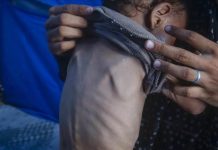Africa-Press – Lesotho. LESOTHO’s HIV response plan is failing to meet the needs of children and adolescents, the Elizabeth Glaser Pediatric AIDS Foundation (EGPAF) Lesotho has said.
The foundation said this in a press statement following the release of the UNAIDS data report titled ‘In Danger’ ahead of the International AIDS Conference which was held in Montreal, Canada, last week.
EGPAF CEO and President, Chip Lyons, described contents of the report as “a chilling indicator of the damning inequities facing children in the fight for an AIDS-free generation and speaks to the focused efforts still needed to end HIV and AIDS in children globally.
He said approximately 160 000 children were newly infected with HIV in 2021 – an unconscionable rate equivalent to 430 new pediatric infections daily.
“Nearly 85 percent of these new vertical infections occurred in sub-Saharan Africa,” he said, adding that the data also shows that while children made up 4 percent of all people living with HIV in 2021, they accounted for 15 percent of all AIDS-related deaths globally.
As the report states, “we can do better at preventing and treating HIV in children. ” “We must ensure mothers and pregnant women living with HIV can safely and regularly access HIV care services,” he said.
According to the report, almost half of all new HIV infections in children are due to HIV-positive mothers not receiving access to HIV testing services and antiretroviral therapy (ART), and yet, ART coverage for pregnant women living with HIV has not meaningfully improved since 2014.
“Engaging pregnant women in care is a foundational first step to decrease the likelihood of transmitting HIV to their babies, while also protecting their own health.
Globally, only 52 percent of children who become infected with HIV are accessing HIV treatment services, whereas the same treatment coverage for adults stands at 76 percent.
“A gap that has continued to grow…this is flat out unacceptable and a far cry from the 95-95-95 target goals,” said Lyons.
“We have the best pediatric diagnostic and treatment tools we have ever had in our fight against HIV. Now, we must deploy them to reduce the growing number of new pediatric HIV infections and, by doing so, close the gaps between adults and children. ”
According to Lyons, “it is incumbent upon the global health community to step up to this achievable challenge and save the lives of kids impacted by HIV and AIDS.
If we are to truly guarantee an AIDS-free generation, the global AIDS response must be laser-focused on addressing these unacceptable inequities by taking deliberate action that prioritises the life of every child at risk of or living with HIV.
Mosonngoa Motseko of the National Aids Commission (NAC) Lesotho said NAC is mandated with providing strategic leadership and governance, efficient and effective coordination and management of the national multi-sectoral and decentralised HIV and AIDS response towards ending AIDS in 2030.
She said despite Lesotho’s achievement of the 90-97-92 targets towards 90-90-90 in HIV response, she still has some challenges amongst children and adolescents.
The UNAIDS “90-90-90” strategy calls for 90% of HIV-infected individuals to be diagnosed by 2020, 90% of whom will be on anti-retroviral therapy (ART) and 90% of whom will achieve sustained virologic suppression.
“We still have pregnant women with high viral load and this increases chances of infection to infants.
” She added: “New infections in children still persist.
The Lesotho civil society organisations (CSOs) Priority Charter was developed in 2021 to guide CSOs when advocating for pediatric HIV and TB in the country.
One of the most troubling inequalities in the HIV response is the failure to achieve HIV and TB targets, especially those related to children and adolescents.
Despite Lesotho meeting the 90-90-90 targets, the country still lags behind in meeting HIV and TB targets among children and adolescents. Thus, the CSO’s Priority Charter is expected to kick-start advocacy work to achieve equality in the country’s HIV and TB response plan.
The charter is expected to guide CSOs to ensure that Lesotho closes the gap between pediatric HIV targets and achievements in the election HIV and TB response.
For More News And Analysis About Lesotho Follow Africa-Press






